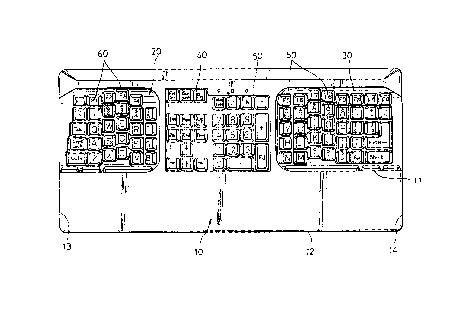Some of the information on this Web page has been provided by external sources. The Government of Canada is not responsible for the accuracy, reliability or currency of the information supplied by external sources. Users wishing to rely upon this information should consult directly with the source of the information. Content provided by external sources is not subject to official languages, privacy and accessibility requirements.
Any discrepancies in the text and image of the Claims and Abstract are due to differing posting times. Text of the Claims and Abstract are posted:
| (12) Patent Application: | (11) CA 2189398 |
|---|---|
| (54) English Title: | ERGONOMIC COMPUTER KEYBOARD |
| (54) French Title: | CLAVIER ERGONOMIQUE POUR ORDINATEUR |
| Status: | Deemed Abandoned and Beyond the Period of Reinstatement - Pending Response to Notice of Disregarded Communication |
| (51) International Patent Classification (IPC): |
|
|---|---|
| (72) Inventors : |
|
| (73) Owners : |
|
| (71) Applicants : |
|
| (74) Agent: | SMART & BIGGAR LP |
| (74) Associate agent: | |
| (45) Issued: | |
| (22) Filed Date: | 1996-11-01 |
| (41) Open to Public Inspection: | 1998-05-01 |
| Examination requested: | 1996-11-01 |
| Availability of licence: | N/A |
| Dedicated to the Public: | N/A |
| (25) Language of filing: | English |
| Patent Cooperation Treaty (PCT): | No |
|---|
| (30) Application Priority Data: | None |
|---|
An ergonomic computer keyboard including a front
edge section, a character control section, an edit
control section, and a number control section, wherein
the character control section includes a left
character control section and a right character
control section, the left character control section
and the right character control section having a
respective hollow, rounded shape; the edit control
section and the number control section are arranged
between the left character control section and the
right character control section.
Clavier d'ordinateur ergonomique, présentant une plage avant, un bloc alphanumérique divisé en deux parties logées chacune dans une dépression de contour arrondi, l'une à droite et l'autre à gauche du clavier, et, entre celles-ci, un bloc numérique et un bloc de touches de directivité.
Note: Claims are shown in the official language in which they were submitted.
Note: Descriptions are shown in the official language in which they were submitted.

2024-08-01:As part of the Next Generation Patents (NGP) transition, the Canadian Patents Database (CPD) now contains a more detailed Event History, which replicates the Event Log of our new back-office solution.
Please note that "Inactive:" events refers to events no longer in use in our new back-office solution.
For a clearer understanding of the status of the application/patent presented on this page, the site Disclaimer , as well as the definitions for Patent , Event History , Maintenance Fee and Payment History should be consulted.
| Description | Date |
|---|---|
| Application Not Reinstated by Deadline | 1999-11-01 |
| Time Limit for Reversal Expired | 1999-11-01 |
| Inactive: Abandoned - No reply to s.30(2) Rules requisition | 1999-01-25 |
| Inactive: Status info is complete as of Log entry date | 1999-01-06 |
| Deemed Abandoned - Failure to Respond to Maintenance Fee Notice | 1998-11-02 |
| Inactive: S.30(2) Rules - Examiner requisition | 1998-09-25 |
| Application Published (Open to Public Inspection) | 1998-05-01 |
| All Requirements for Examination Determined Compliant | 1996-11-01 |
| Request for Examination Requirements Determined Compliant | 1996-11-01 |
| Abandonment Date | Reason | Reinstatement Date |
|---|---|---|
| 1998-11-02 |
Note: Records showing the ownership history in alphabetical order.
| Current Owners on Record |
|---|
| SHIH-MING CHENG |
| Past Owners on Record |
|---|
| None |